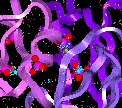 Molecular Dynamics - The
Choice of Timestep
Molecular Dynamics - The
Choice of Timestep Molecular Dynamics - The
Choice of Timestep
Molecular Dynamics - The
Choice of TimestepThe timestep used depends on the system as well as the integrators. The main limitation imposed by the system is the highest-frequency motion that must be considered. A vibrational period must be split into at least 8-10 segments for molecular systems to satisfy the Verlet assumption that the velocities and accelerations are constant over the timestep used. In most molecular systems, the highest vibrational frequency is that of C-H bond stretching, whose period is on the order of 10-14 s. The integration timestep should therefore be about 1 fs. In the Discover program, the default timestep for the Verlet leapfrog and Verlet velocity methods is 1 fs.
The timestep must also be appropriate to the integrator. In a molecular system, 1 fs seems to be good for the Verlet algorithm. However, for the ABM4 method, 0.5 fs is more appropriate. The Runge-Kutta method seems to require a even smaller timestep, on the order of 0.05 fs.
 Main
access page
Main
access page  Theory/Methodology access.
Theory/Methodology access.
 Dynamics access
Dynamics access
 Dynamics - Integration Algorithms
Dynamics - Integration Algorithms
 Dynamics - Integration Errors
Dynamics - Integration Errors
Copyright Biosym/MSI